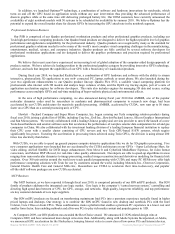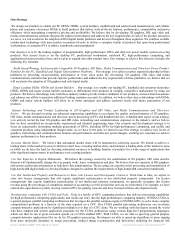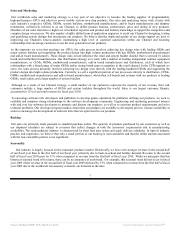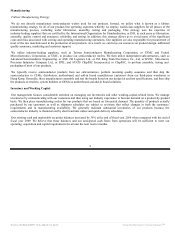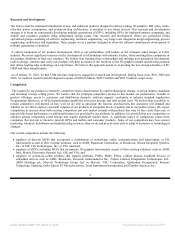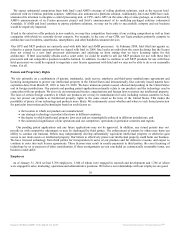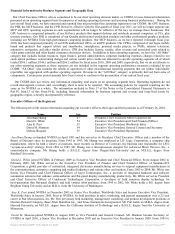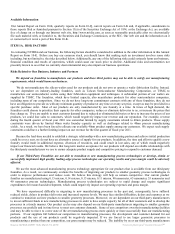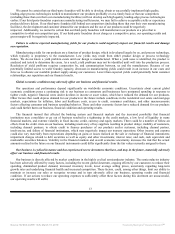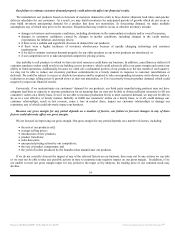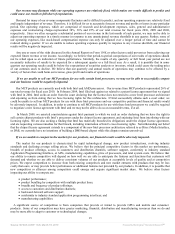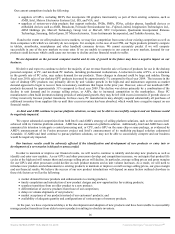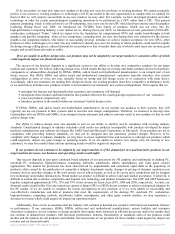NVIDIA 2010 Annual Report Download - page 16
Download and view the complete annual report
Please find page 16 of the 2010 NVIDIA annual report below. You can navigate through the pages in the report by either clicking on the pages listed below, or by using the keyword search tool below to find specific information within the annual report.
We expect substantial competition from both Intel’s and AMD’s strategy of selling platform solutions, such as the success Intel
achieved with its Centrino platform solution. AMD has also announced a platform solution. Additionally, Intel and AMD have each
announced its intention to integrate a central processing unit, or CPU, and a GPU on the same chip or same package, as evidenced by
AMD’s announcement of its Fusion processor project and Intel’s announcement of its multichip packaged solution codenamed
Arrandale. If AMD and Intel continue to pursue platform solutions, we may not be able to successfully compete and our business
would be negatively impacted.
If and to the extent we offer products in new markets, we may face competition from some of our existing competitors as well as from
companies with which we currently do not compete. For example, in the case of our CPB, our Tegra products primarily compete in
architecture used in tablets, smartbooks, smartphones, and other handheld consumer devices.
Our GPU and MCP products are currently used with both Intel and AMD processors. In February 2009, Intel filed suit against us,
related to a patent license agreement that we signed with Intel in 2004. Intel seeks an order from the court declaring that the license
does not extend to a new Intel processor architecture and enjoining us from stating that we have licensing rights for this
architecture. If Intel successfully obtains such a court order, we could be unable to sell our MCP products for use with these Intel
processors and our competitive position would be harmed. In addition, in order to continue to sell MCP products for use with these
Intel processors we could be required to negotiate a new license agreement with Intel and we may not be able to do so on reasonable
terms, if at all.
Patents and Proprietary Rights
We rely primarily on a combination of patents, trademarks, trade secrets, employee and third-party nondisclosure agreements and
licensing arrangements to protect our intellectual property in the United States and internationally. Our currently issued patents have
expiration dates from March 25, 2010 to June 18, 2029. We have numerous patents issued, allowed and pending in the United States
and in foreign jurisdictions. Our patents and pending patent applications primarily relate to our products and the technology used in
connection with our products. We also rely on international treaties, organizations and foreign laws to protect our intellectual property.
The laws of certain foreign countries in which our products are or may be manufactured or sold, including various countries in Asia,
may not protect our products or intellectual property rights to the same extent as the laws of the United States. This makes the
possibility of piracy of our technology and products more likely. We continuously assess whether and where to seek formal protection
for particular innovations and technologies based on such factors as:
• the location in which our products are manufactured;
• our strategic technology or product directions in different countries;
• the degree to which intellectual property laws exist and are meaningfully enforced in different jurisdictions; and
• the commercial significance of our operations and our competitors’ operations in particular countries and regions.
Our pending patent applications and any future applications may not be approved. In addition, any issued patents may not
provide us with competitive advantages or may be challenged by third parties. The enforcement of patents by others may harm our
ability to conduct our business. Others may independently develop substantially equivalent intellectual property or otherwise gain
access to our trade secrets or intellectual property. Our failure to effectively protect our intellectual property could harm our business.
We have licensed technology from third parties for incorporation in some of our products and for defensive reasons, and expect to
continue to enter into such license agreements. These licenses may result in royalty payments to third parties, the cross licensing of
technology by us or payment of other consideration. If these arrangements are not concluded on commercially reasonable terms, our
business could suffer.
Employees
As of January 31, 2010 we had 5,706 employees, 3,940 of whom were engaged in research and development and 1,766 of whom
were engaged in sales, marketing, operations and administrative positions. We believe our relationships with our employees are good.
10
Source: NVIDIA CORP, 10-K, March 18, 2010 Powered by Morningstar® Document Research℠




